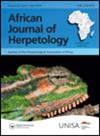博斯克缘趾蜥突尼西亚种群性别大小的二态性
IF 0.9
4区 生物学
Q3 ZOOLOGY
引用次数: 4
摘要
研究不同地方种群性别大小二态性的变化模式,可能有助于理解蜥蜴的大小进化。我们研究了突尼斯博斯克边缘趾蜥蜴种群与中东同一亚种种群的性别大小二态性模式。研究结果表明,乳草科动物总体上存在雄性偏大的体型二态现象,这与雌性体型二态现象的普遍趋势一致,为繁殖力优势假说和性内选择假说提供了支持。事实上,对于同样大小的头部,雌性的躯干比雄性长,而对于同样大小的躯干,雄性的头部比雌性大。使用判别函数方法,我们研究了当形态测量测量相对于头长和躯干长度表示时,性别之间的辨别能力是否会发生变化。我们发现,这两种方法在将个体分类为男性或女性方面是一致的,尽管当数据相对于头长表示时,歧视力略高。我们的研究结果还表明,当使用躯干长度调整后的数据时,当分析仅限于最大的个体时,区分性别的能力更高,这支持了应该使用最大个体的小亚样本进行形态学调查的想法。总的来说,我们的工作结果支持了最近对同一亚种的中东种群的性别大小二态性研究的结论,表明性别大小二态性模式在这个广泛分布的亚种中是稳定的。本文章由计算机程序翻译,如有差异,请以英文原文为准。
Sexual size dimorphism in a Tunisian population of Bosk's fringe-toed lizards Acanthodactylus boskianus asper
Abstract Investigating how patterns of sexual size dimorphism vary among local populations may be useful for understanding size evolution in lizards. We investigated patterns of sexual size dimorphism in a Tunisian population of Bosk's fringe-toed lizards Acanthodactylus boskianus asper, in relation to a Middle-eastern population of the same subspecies. Our results showed an overall male-biased size dimorphism, consistent with general sexual size dimorphism trends in lacertids, and provide support for both the fecundity advantage hypothesis and the intra-sexual selection hypothesis. Indeed, for similarly-sized heads, females had longer trunks than males, and for similarly-sized trunks, males showed larger heads than females. Using the discriminant function approach, we investigated whether the power of discrimination between sexes varied when morphometric measures were expressed relative to head length vs. trunk length. We found that the two methods agreed in the classification of individuals as males or females, although the discrimination power was slightly higher when data were expressed relative to head length. Our results also showed that when using trunk length-adjusted data the power of discriminating the sexes was higher when the analysis was restricted to the largest individuals, which gives support to the idea that for morphological investigations small subsamples of the largest individuals should be used. Overall, the results of our work support the conclusions of a recent study on sexual size dimorphism in a Middle-eastern population of the same subspecies, suggesting that patterns of sexual size dimorphism are geographically stable in this widely distributed subspecies.
求助全文
通过发布文献求助,成功后即可免费获取论文全文。
去求助
来源期刊

African Journal of Herpetology
ZOOLOGY-
CiteScore
3.00
自引率
6.70%
发文量
15
审稿时长
>12 weeks
期刊介绍:
African Journal of Herpetology (AJH) serves as an outlet for original research on the biology of African amphibians and reptiles. AJH is an interdisciplinary journal that publishes original articles and reviews from diverse fields and disciplines, such as conservation, phylogenetics, evolution, systematics, performance, physiology, ecology, behavioural ecology, ethology, and morphology.
The Journal publishes two issues a year. There are no page charges .
 求助内容:
求助内容: 应助结果提醒方式:
应助结果提醒方式:


